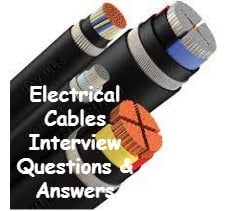
The following electrical Cables Interview Questions & Answers are very important and may be asked in interviews. The most important electrical Cables Interview Questions & Answers are as follows.
What is underground cable & Where is it Used?
The underground cables are the cables laid and buried in the ground to transmit the power. The underground cables are preferred for the area where construction is practically impossible like in large cities.
Why is metallic sheath provided in underground cables?
The metallic sheath is provided around the insulation to protect the cable against ingress of ;
- Moisture
- Gas
- Other damaging liquids (acid or alkalies)
What are the types of cables used for transmission & distribution systems?
- For low & medium voltage – P.V.C cables are used.
- High voltage lines — XLPE and PILC cables are used.
- Extra high voltage lines – XLPE, oil-filled, gas-filled, and gas pressure or compression cables are used.
What are the salient features of the insulation materials used for underground cables?
The salient desired features of insulating material used for underground cables are as follows.
- High insulation resistivity
- High dielectric strength
- Good mechanical properties
- Non-hygroscopic
- Non-inflammable
- Immune to attacks by acids and alkalies.
What are the advantages and disadvantages of oil-filled cables?
Oil-filled cable is an obsolete product. The advantages and disadvantages of oil-filled cables are listed below.
Advantages:
- The dielectric strength of the oil used as an insulating medium is higher than PVC and XLPE. This leads to an overall reduction in cable size for a given voltage rating. The weight of the cable is also reduced because of the reduction in the thickness of the conductors.
- There are no chances of formation of voids and thus it leads to no ionization and oxidation.
- Perfect paper impregnation
- Smaller thermal resistance due to decrease in the dielectric thickness, so higher current rating
- More maximum permissible stresses
- Fault identification is easy
- Lack of sensitivity to dc testing
- Very reliability
- Excellent corrosion resistance.
Disadvantages:
- Greater cost
- Complicated laying of cables and maintenance
- The heavy weight of lead metal on PILC cause increases labor intensity, making it more costly to install.
- Lead is harmful
What are the advantages of XLPE cables compared to PVC cables?
XLPE cables have the following good properties.
- Withstand higher temperature (900C) compared to PVC (700C)
- Higher over-load capacity
- Lighter in weight and smaller bend radius hence lower installation cost
- Has high short circuit rating
- It has lower dielectric and constant power factor which can result in saving of power
What are the different insulation materials used in cables for high voltage and medium voltage?
Medium Voltage:(From 1000 V to 35 kV)
- Polyethylene (PE)
- Cross-linked polyethylene (XLPE)
- Tree retardant cross-linked polyethylene (TR-XLPE)
- Ethylene-Propylene Elastomers (EPR)
- PILC
High Voltage:( Over 35 kV)
- Cross-linked polyethylene (XLPE)
- Paper/Oil
- Paper/Polypropylene
- SF6 gas